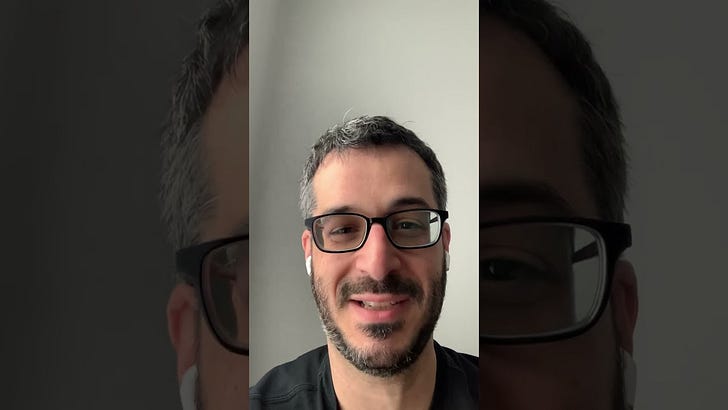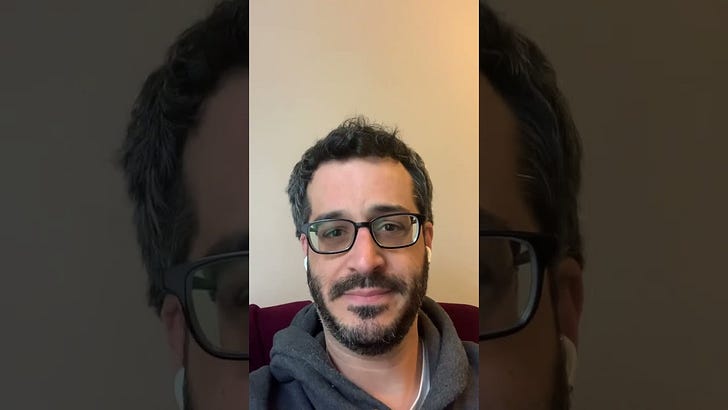If the embedded audio narration isn’t working properly or doesn’t sound good, tap this button to switch over to the podcast version.
In last month’s issue, I looked at the facts and worldviews that frame our perspective at this moment as we look ahead to the growth we can expect in the coming months and years.
In this month’s issue, I talk about the meaning of our work (before the next upswing makes everybody forget about it).
Hard times make . . .
This month, VCs, market makers, trading firms, and exchanges blew up. People smarter than me say the worst is yet to come.
Terrible news for anybody who lost money on an exchange or a bad business deal. Some people saw fortunes disappear. Some businesses will close forever.
Meanwhile, bitcoin will continue to churn out block after block. Aave will continue to settle financial arrangements. Chainlink will continue to feed prices and real-world data into distributed networks.
Businesses die. People steal money.
Protocols persist.
Maybe that’s the thing everybody misses when they say cryptos “do nothing?”
Maybe cryptocurrencies don’t need need to pay dividends, generate yield, have government backing, or offer “intrinsic value.” They just need to incentivize and reward people for doing things.
Their value comes from what people do with them. Whether that value gets captured at a higher price depends on the token structure, though speculative enthusiasm certainly plays a role.
What if it doesn’t matter what happens to 3AC, Genesis, or any other entity that operated in the legacy financial system? They’ll disappear, default, dissolve, or die.
Cryptocurrency will not.
Fraud? Theft? Failure? Bankruptcy?
Protocols persist.
We buy into protocols, not people. Tokens, not firms. Financial networks, not social circles.
We bet that the successful cryptocurrencies offer more durable, lasting, and sticky returns than legacy assets.
Look out below?
About those legacy assets. . .
In a recent post on Mirror and other outlets, I showed you this picture:
That blue line is M2, a common measure of the US money supply. See its full glory.

M2 is not the only measure of money, but it’s the easiest to calculate and understand. It’s the total amount of dollar-denominated cash and cash equivalents in the world.
That line has gone straight up for years. Now it’s curving down.
Does this remind you of anything? Maybe something like this?
Yes, the classic “anatomy of a bubble diagram” just before the collapse. A new paradigm for dollars.
If this were any other asset, the Doomsburgers would scream “IT’S ABOUT TO CRASH!!!”
That’s nonsense. M2 is not an asset, it’s an arbitrary measure of the quantity of US dollars.
This is not a price chart. The bubble diagram is irrelevant and the United States government can make this line go wherever it wants it to. If the US money supply crashed like that, the world would plunge into deflation and an economic crisis.
Fed Chairman Powell says he’d rather have that than inflation. Something tells me he’ll change his mind once the bodies hit the floor.
After a decade of returns financed by buy-backs and easy money policies, stock investors are laughing at crypto. “Real” businesses think it’s a scam.
Why do they think Wall Street’s schemes are any more sustainable? For those who compare LUNA or FTX to Lehman Brothers, what makes you so sure the US stock market won’t have its own Lehman Brothers moment in 2023, as capital costs squeeze unprofitable businesses, falling revenue forces defaults and restructuring of corporate debts, inflation and/or recession crush earnings, and lower liquidity exposes frauds and financial shenanigans every bit as serious as FTX’s?
Did everybody forget that the UK pension system nearly collapsed this summer? Does nobody remember that China’s housing market almost imploded last year?
Can we assume governments can avoid close calls forever?
What if we’ve just been lucky so far? Historically, western economies get a financial meltdown every decade. We’re due.
Er, and crypto?
Mark, everything you just said sounds like a reason to get out of crypto…
No, it’s a reason to hedge against the legacy financial system. Cryptocurrency is one way to do that. No matter what happens in the wider world, protocols persist.
Crypto prices have reached levels we haven’t seen since 2020.
With bitcoin, you’re getting more upside with less downside than you have in years.
With altcoins, you’re getting more upside for the same amount of risk you’ve always had (100% loss).
On top of that, tighter global monetary conditions will force more altcoins to fail sooner than they would have under looser global monetary conditions. This frees up more capital for “good” projects and keeps you from throwing too much money into losers as you allocate over time.
I’m still buying an altcoin every other week until I finish raising my allocations to all of my altcoins. It’s all part of my portfolio strategy.
While you’re thinking about crypto, don’t sleep on government bonds. In the US, I’m talking about T-bills and treasury notes, not savings bonds. You’re getting the best deal in a generation.
In your country, maybe not, but it’s probably a better return than you’ll get from your bank as long as you won’t need to withdraw cash for at least a month—with roughly the same risk as holding your government’s money.
Speaking of cash. Some say it’s trash, but its utility makes up for the costs and risks of holding it.
In 2023, you might get great deals on anything people normally finance with debt, e.g., cars, houses, boats, major appliances and such.
Unless central banks change course, financial stress will force owners to sell these things at lower prices, boosting the supply of used or refurbished units. Tighter monetary conditions are already holding back demand and a glut of inventory from 2022 backlogs and overproduction will make it hard for sellers to hold their prices.
Get your crypto now so you’ll have cash ready for 2023 discounts on those other investments and big-ticket items. My plan can help you with that.
If you chose to dollar cost average, you’re down 66% this year and down 48% since I published my plan. If you had followed my plan, you could be down that much at the extreme, but you’re probably closer to down 25% and possibly up as much as 200%.
Now is the only time you get a good price for altcoins
Mark, you’re a bitcoin guy, why do you shill altcoins?
I don’t shill.
Bitcoin can do everything altcoins can do, but that will take a lot of engineering and development. Altcoins get to start from scratch.
Besides, I’m set with my bitcoin allocation. I have more now than I ever thought I ever would.
Market bottoms are the best time to buy altcoins. Some might argue they’re the only time to buy altcoins.
Pull up a chart of any altcoin and you’ll see it almost never beats bitcoin from peak to peak.
From bottom to top? Different story.
Look at the average altcoin’s performance against bitcoin from the bottoms of bear markets to the tops of bull markets. We can use Ethereum as a proxy.
You did better in the “bear” markets, even as your portfolio sometimes trended lower against bitcoin for some periods of time.
Let’s also compare the returns from buying the bottoms of bear markets compared to buying after the bull market’s confirmed. Take a look.
Even if you buy before, after, and higher than the bottom, you come out way ahead.
If you wait for the bull market, you’ll miss out on a lot of growth—but you’ll still risk a 100% loss.
I’ll buy an initial stake in any altcoin in any market conditions. I only raise my allocations during times like these, as I did in November 2020 and July/August 2021.
Since the end of May, I’ve bought an altcoin every other week.
For paid subscribers, I shared what altcoin I bought and also reviewed five or ten large-cap altcoins with each update. Also, my occasional altcoin reports, including a new report from earlier this month.
Mark, will you bring back your altcoin research service?
Thanks for asking. You remembered Altcoin Insights!
Sorry, no.
I’m glad I did it, but it was a lot of work that nobody appreciated. Worse, insane 2021 prices made it really hard to find projects worth recommending. On top of that, most subscribers didn’t really care about the investment opportunity, they only wanted to make as much money as possible as quickly as possible, which isn’t my thing.
I’ve thought about bringing it back because pretty much anybody who would subscribe during these market conditions would have an honest desire to get good, brief, substantive research on new, experimental financial projects.
I simply can’t price that service high enough to justify the time and stress that goes along with it. Hopefully, my brief reviews and altcoin reports will suffice.
What happens when the VCs leave?
You might worry that altcoins will fall apart once the VC money disappears.
We’ll see.
After I got into crypto, the flow of private capital into altcoins exploded. Has it done any good?
While private funding helps projects get off the ground, it gives teams less incentive to care about the community. They get their money from booster, not us.
In some cases, more than 40% of tokens go straight to early backers who gave money prelaunch for free or discounted tokens. That’s a lot of rewards for people who contribute nothing to the protocol or its network, as I discuss in this video.
Compare that to bitcoin and some other altcoins, where you need to give something to the network in order to get tokens. You have to put in some work to earn your keep.
In one sense, VC money protects and incubates projects. Development can happen without the social pressure of “why didn’t the price go up” or stress when the market goes too high or low. Building without hype and FOMO has its benefits.
In another sense, that flips the core altcoin paradigm on its head.
As people and communities build and grow the protocols, VCs take their rewards—a type of rent-seeking activity that crypto is supposed to eliminate.
In doing so, VCs have morphed the industry into something much closer to the legacy system that they say they want to replace.
The irony.
Good people can disagree on whether VCs and institutions are good or bad for crypto. You get more money, interest, and talent but also lose the natural, healthy, organic growth that’s essential for durable value and massive returns.
Maybe it all balances out over time. The market gets ahead of itself, then falls back to where it should be.
In the end, we're wagering our fortunes on the outcome of speculative financial experiments. As long as we benefit, does it matter how the projects succeed? Can’t some of these VC tokens do amazing things, too?
Progress comes in fits and starts
Great things rarely come from ideological purity or clever design.
Serendipity, risk, luck, effort, creativity, money, vision, and timing play a role.
Nobody knows how much of each gives you the best mix for success. That’s the adventure. Discovery has its own reward, especially when the best discoveries can grow your wealth in ways the legacy system can’t.
Technology does not decide its own fate. We do. Step by step, year after year. One person’s work builds on another’s. Market forces drive prices up and down, sometimes at a whim.
We need clear laws, frameworks, standards, and transparency so earnest builders will not get lumped in with scammers, developers can innovate without fear of jail or censure, and communities can grow without frauds and charlatans stealing their money.
That’s the next step. It’s a hard one, but we have a lot of great people advocating on our behalf.
The longest yard
While they work, let’s not lose perspective on the problem we’re trying to solve:
The legacy financial system can’t give people the lives that they want. The closed systems of control can no longer keep up with the demographic, social, and technological changes that drive modern commerce and communications.
Cryptocurrency offers an alternative but its fate depends on the devotion of builders, developers, and investors.
That devotion doesn’t reveal itself in the next 100x altcoin, a new data model, or some on-chain metric that most people don’t interpret properly.
It comes from people like us who understand the power of this technology to change our contemporary notions of wealth and finance—and in doing so, give normal people a chance to own a stake in the future, rather than the scraps of whatever trickles down from those who hold power.
What does that future look like?
Nobody knows yet.
That’s the beauty and excitement of this world we’re trying to build.
One vision is the one I present in Consensusland. Another vision is Satoshi’s. Another vision is Vitalik’s and dozens of other visions, all possible, none inevitable.
These visions don’t come with price tags. They transcend market conditions and reflect something far more powerful than whatever price your CoinGecko app shows you on any given day.
Obsess over prices and you’ll miss the revolution.
Protocols persist.
Do you?
Relax and enjoy the ride!













